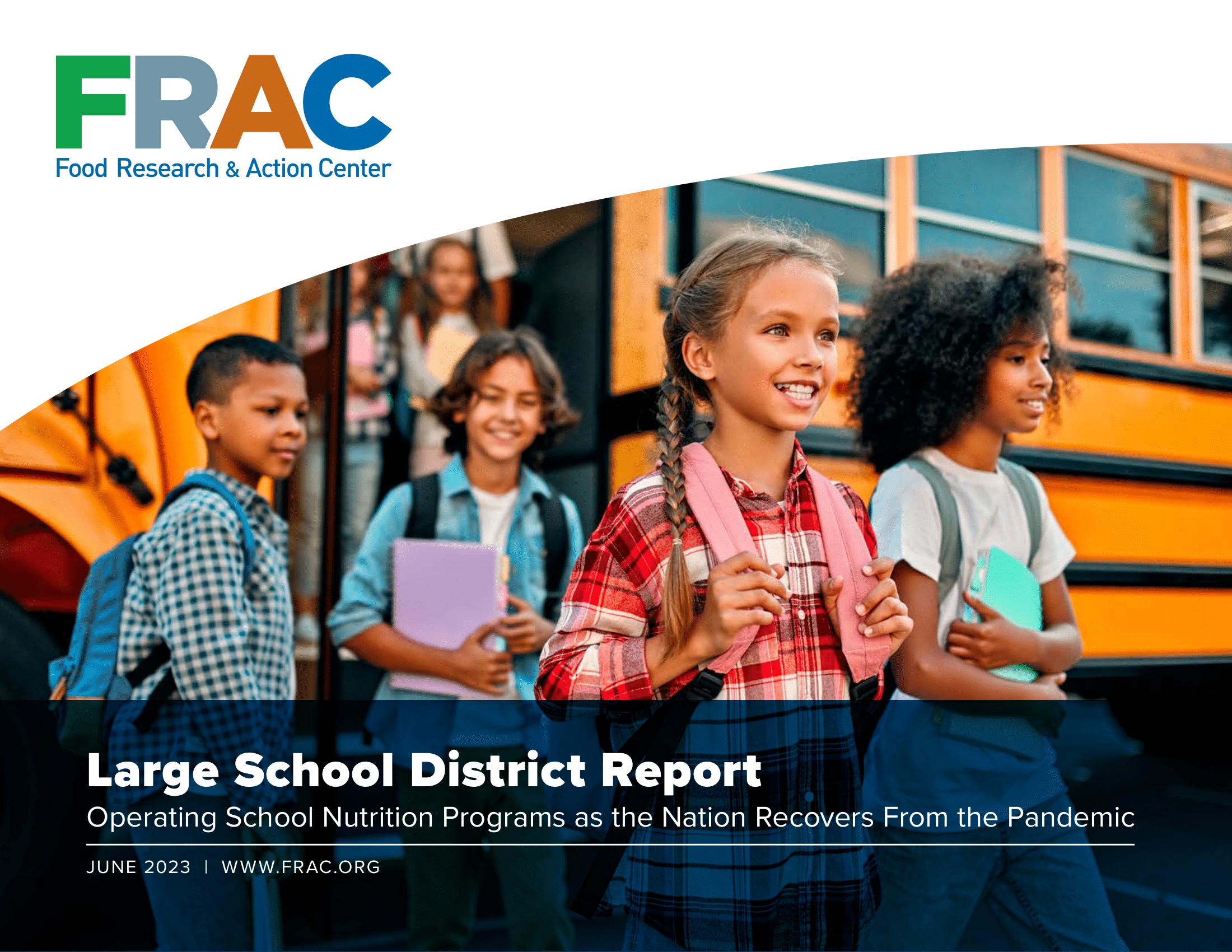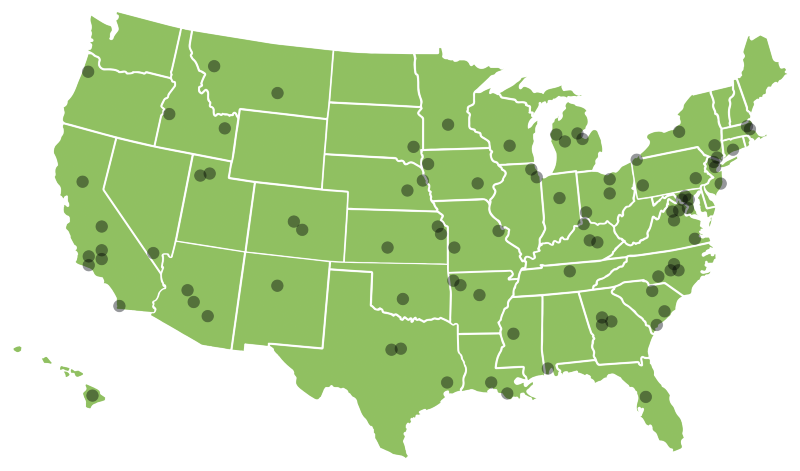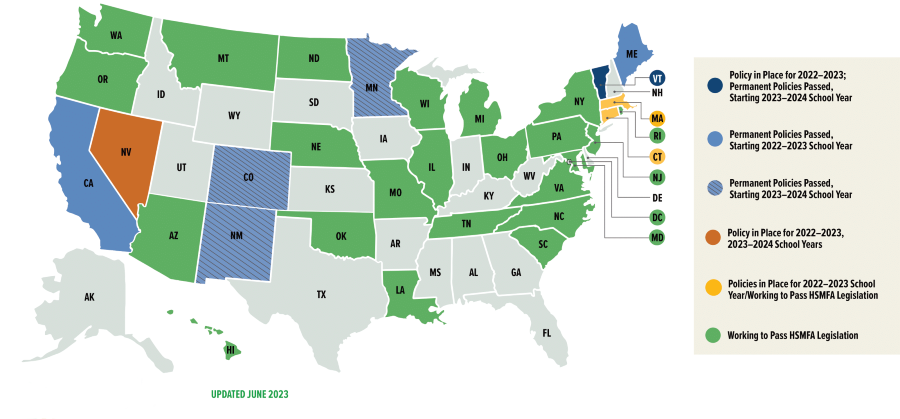Many large school districts across the country reported decreased participation in school breakfast and lunch when the nationwide child nutrition waiver that allowed schools to offer school meals to all of their students at no charge ended, according to FRAC’s latest report, Large School District Report: Operating School Nutrition Programs as the Nation Recovers from the Pandemic.
Key Findings
-
- The 91 school districts highlighted in this report included a total of 10,748 schools representing 6,520,586 students.
- Average daily participation in breakfast decreased by more than 100,000 students across all surveyed districts — from 1.84 million children participating in breakfast each day in April 2022 to 1.74 million participating daily in October 2022.
- Average daily participation in lunch decreased by more than 250,000 students — from 3.61 million students participating in lunch each day in April 2022 to 3.36 million participating daily in October 2022.
- Collectively, most school districts served fewer children both school breakfast and lunch in October 2022 compared to April 2022. Thirty-three districts saw an increase in breakfast participation from April 2022 to October 2022, and 28 districts saw an increase in lunch participation from April 2022 to October 2022.

Credit: Fulton County Schools

Large School District Report 2023
Read the report
Press Release
Read the news release!
About Our Survey Sample
FRAC surveyed 91 districts across 40 states and the District of Columbia on their school meals participation and operations in April 2022 and October 2022, covering school years 2021–2022 and 2022–2023, respectively. District size ranged from 7,353 students in Inglewood Unified School District (California) to 996,959 students in the New York City Department of Education (New York).

End of Most USDA Waivers Leads to Reduced Participation
During the 2021–2022 school year, the U.S. Department of Agriculture (USDA) extended nationwide pandemic-related waivers that gave districts the flexibility to operate child nutrition programs during volatile circumstances, such as labor shortages, supply chain disruptions, and school closures.

Every school district included in this report used at least one waiver in April 2022, with all surveyed districts utilizing the Seamless Summer Option (SSO) waiver.

Unwinding the Pandemic-Era Waivers
The nationwide waivers available at the onset of the COVID-19 pandemic were not widely available in the 2022–2023 school year.
In October 2022, 75 percent (68) of districts reported not using any waivers.
With the loss of many federal waivers, along with ongoing pandemic-related issues in the 2022–2023 school year, districts continued to face a variety of challenges that decreased students’ access to healthy school meals, such as increased costs and school meal debt, supply chain disruptions, and labor shortages. Most districts had to return to a tiered eligibility system that requires them to collect, process, and verify school meal applications, and millions of children lost access to free school meals.
Collectively, surveyed districts experienced a 5 percent decrease in average daily breakfast participation in October 2022 compared to April 2022, serving more than 100,000 fewer children each school day. Districts also saw a decrease in school lunch participation by over 250,000 students — from 3.61 million students participating in lunch each day in April 2022 to 3.36 million participating daily in October 2022.
Momentum Builds for Healthy School Meals for All
Offering school meals to all students at no charge supports parents and guardians, decreases child hunger, eliminates stigma, and streamlines food service operations.
Indeed, concern over losing the opportunity to offer all students healthy school meals ignited action among states and school districts. Six states have adopted Healthy School Meals for All policies on a permanent basis. And nearly 7,000 more schools implemented the Community Eligibility Provision (CEP), which allows high-need districts and schools to offer school breakfast and lunch at no charge to all students, bringing the total number of schools adopting community eligibility to 40,235.

To ensure that children have access to healthy meals, and that districts have the support needed to operate robust programs, school meals must be available to all students at no charge.
School Districts Sound Off On Healthy School Meals for All

-
“[Offering free meals to all students] increases meal participation that supports program viability” – Newton Public Schools
-
“[Serving free meals to all students] improved employee morale in not having to tell a child that they owe money” — Peoria Unified School District
Recommendations

Make School Meals Available to All Students at No Charge
Offering meals to all students at no cost provides the nutritional foundation that children need to grow, learn, and thrive. It also reduces stigma, supports academic achievement, and reduces families’ household food costs. For districts, offering free school meals to all students supports program viability by increasing participation, streamlining operations, reducing administrative burden, and eliminating school meal debt. Federal legislation, such as the Universal Free School Meals Program Act of 2023 (S. 1568), would help ensure that every student in every state has access to school meals, as well as the nutrition they need after school, during the summer, and at child care.
The Community Eligibility Provision (CEP) is an important opportunity to increase the number of schools offering healthy school meals to all students at no charge. To fully leverage community eligibility, Congress must increase the amount of federal funding the provision provides. The School Meals Expansion Act of 2023 (H.R. 2567) would increase the community eligibility multiplier from 1.6 to 2.5, thus increasing the amount of federal funding a CEP school receives, and would lower the eligibility threshold to 25 percent, which is consistent with USDA’s Proposed Rule.

Increase School Meal Reimbursements
Federal administrative and legislative action must support the financial viability of the school nutrition programs so that operators can continue serving students the most nutritious and appealing meals possible. The Healthy Meals Help Kids Learn Act of 2023 (H.R. 1269) would permanently increase the federal reimbursement rates for school breakfast by $0.28 and school lunch by $0.45, with a yearly adjustment for inflation.

Support Breakfast After the Bell Models
Making breakfast a part of the school day overcomes common school breakfast participation barriers and increases participation, helping to ensure that students can start the school day ready to learn. Local, state, and national initiatives that support breakfast after the bell models, such as additional school breakfast funding and supportive policies, will increase participation and ensure students have access to the nutrition needed for academic achievement.
